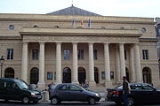
Odéon
Encyclopedia
The Odéon-Théâtre de l'Europe (formerly the Théâtre de l'Odéon) is one of France's six national theatres
.
It is located at 2 rue Corneille in the 6th arrondissement of Paris on the left bank of the Seine
, next to the Luxembourg Garden. It was originally built between 1779 and 1782, in the garden of the former Hôtel de Condé
, to a Neoclassical design by Charles De Wailly
and Marie-Joseph Peyre
, originally in order to house the Comédie Française, which, however, preferred to stay at the Théâtre-Français in the Palais Royal
. The new theatre was inaugurated by Marie-Antoinette on April 9, 1782. It was there that The Marriage of Figaro
play was premiered two years later.
An 1808 reconstruction of the theater designed by Jean Chalgrin
(architect of the Arc de Triomphe
) was officially named the Théâtre de l'Impératrice, but everyone still called it the Odéon. It burned in 1818.
The third and present structure, designed by Pierre Thomas Baraguay, was opened in September of 1819. In 1990, the theater was given the sobriquet
'Théâtre de l'Europe'. It is a member theater of the Union of the Theatres of Europe
.
Theater (structure)
A theater or theatre is a structure where theatrical works or plays are performed or other performances such as musical concerts may be produced. While a theater is not required for performance , a theater serves to define the performance and audience spaces...
.
It is located at 2 rue Corneille in the 6th arrondissement of Paris on the left bank of the Seine
Seine
The Seine is a -long river and an important commercial waterway within the Paris Basin in the north of France. It rises at Saint-Seine near Dijon in northeastern France in the Langres plateau, flowing through Paris and into the English Channel at Le Havre . It is navigable by ocean-going vessels...
, next to the Luxembourg Garden. It was originally built between 1779 and 1782, in the garden of the former Hôtel de Condé
Hôtel de Condé
The Hôtel de Mademoiselle de Condé, 12 rue Monsieur , has been referred to simply as the Hôtel de Condé, but this name can result in confusion, as it was also used for the main Paris seat of the princes of Condé. The building is also called the Hôtel de Bourbon-Condé, since it was built for Louise...
, to a Neoclassical design by Charles De Wailly
Charles De Wailly
Charles De Wailly was a French architect and urbanist, and furniture designer, one of the principals in the Neoclassical revival of the Antique. His major work was the Théâtre de l'Odéon for the Comédie-Française...
and Marie-Joseph Peyre
Marie-Joseph Peyre
Marie-Joseph Peyre was a French architect who designed in the neoclassical style.- Biography :He began his training in Paris with Jacques-François Blondel at l'École des Arts, where he met Giovanni Niccolo Servandoni and formed a life-long friendship with Charles De Wailly...
, originally in order to house the Comédie Française, which, however, preferred to stay at the Théâtre-Français in the Palais Royal
Palais Royal
The Palais-Royal, originally called the Palais-Cardinal, is a palace and an associated garden located in the 1st arrondissement of Paris...
. The new theatre was inaugurated by Marie-Antoinette on April 9, 1782. It was there that The Marriage of Figaro
The Marriage of Figaro (play)
The Marriage of Figaro ) is a comedy in five acts, written in 1778 by Pierre Beaumarchais. This play is the second installment in the Figaro Trilogy, preceded by The Barber of Seville and followed by The Guilty Mother. The Barber begins the story with a simple love triangle in which the Count has...
play was premiered two years later.
An 1808 reconstruction of the theater designed by Jean Chalgrin
Jean Chalgrin
Jean-François-Thérèse Chalgrin was a French architect, best known for his design for the Arc de Triomphe, Paris.-Biography:...
(architect of the Arc de Triomphe
Arc de Triomphe
-The design:The astylar design is by Jean Chalgrin , in the Neoclassical version of ancient Roman architecture . Major academic sculptors of France are represented in the sculpture of the Arc de Triomphe: Jean-Pierre Cortot; François Rude; Antoine Étex; James Pradier and Philippe Joseph Henri Lemaire...
) was officially named the Théâtre de l'Impératrice, but everyone still called it the Odéon. It burned in 1818.
The third and present structure, designed by Pierre Thomas Baraguay, was opened in September of 1819. In 1990, the theater was given the sobriquet
Sobriquet
A sobriquet is a nickname, sometimes assumed, but often given by another. It is usually a familiar name, distinct from a pseudonym assumed as a disguise, but a nickname which is familiar enough such that it can be used in place of a real name without the need of explanation...
'Théâtre de l'Europe'. It is a member theater of the Union of the Theatres of Europe
Union of the Theatres of Europe
The Union of the Theatres of Europe is an alliance of European public theatres. It serves to promote European integration through cultural interaction....
.

